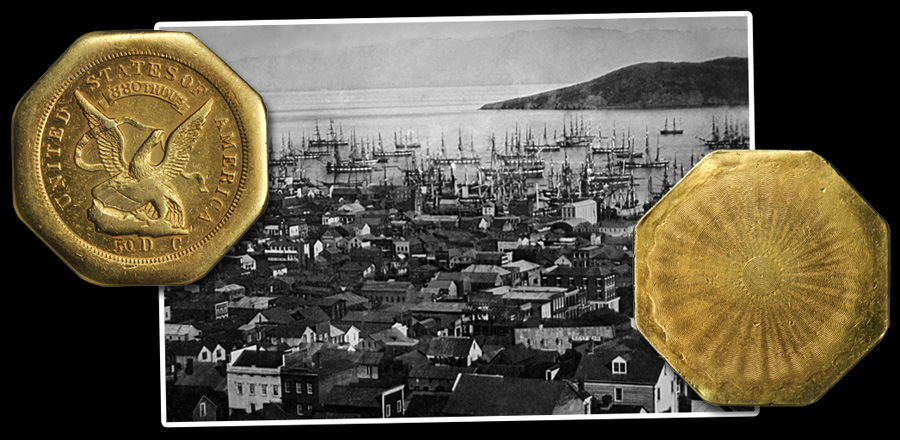
The history of the piece is ably outlined in our catalog description: “The United States Assay Office was formed under the guiding hand of Moffat & Company. Prior to 1851 several private minters issued gold coins in California, but standards varied and many were seen as issuing lightweight coins. When Augustus Humbert arrived in San Francisco with new coining dies for the $50 denomination, the date was January 30, 1851 and new coins were struck at his office the very next day. The unique octagonal shape of the $50 gold coins soon became a symbol of the coinage of California. The reverse design includes the elegant ‘engine turned’ design seen on pocket watches, and was adapted to these large format gold coins by C.C. Wright. Albert Küner who was local to San Francisco engraved later dies. These new coins were of uniform size and weight, and were acceptable for duties at the Customs House in town. Sadly, the initial legislation did not include authorization for smaller denominations, so the vast shortage of silver and smaller denomination gold coins continued for a few more years, despite the efforts of some private mints in that area, as well as coins arriving from eastern mints to try to offset the shortages in California. These problems would persist until the San Francisco Mint opened for business in 1854 and coinage supplies slowly normalized in California for the duration of the Gold Rush.”
The featured coin, an NGC-certified AU-58+ 1851 Augustus Humbert octagonal $50 gold “slug” or “ingot” (as they were officially called), is Kagin-2 and Rarity-5 for particulars. This popular issue features a lettered edge, is designated 880 THOUS on the ribbon, and is without “50” at the center of the reverse. What makes this particular Choice AU piece so unusual is the fact that the lettering on the edge was routinely entered individually on each of the eight sides and reads AUGUSTUS HUMBERT UNITED STATES ASSAYER OF GOLD CALIFORNIA 1851. The present piece was blundered by the firm, with OF GOLD appearing twice, once where it belongs in the scheme of things, and a second time over the date, thus reading OF GOLD/1851 on one of the eight edges.
How rare is this error edge style? In all our years, this is the first one we recall seeing, though it is entirely probable that another, or more, do exist. No matter, we suspect that more than one advanced private gold specialist will have this pleasing rarity on his or her numismatic shopping list when the bidding begins, with the coin no doubt sparking a mini-gold rush all its own. If you collect private or territorial gold coins, we suggest this star will shine brightly in your collection.





